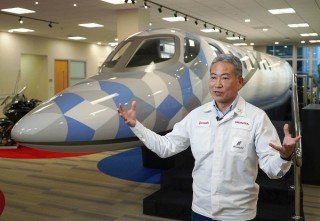Loading
Search
▼ Honda Aircraft Aims to Increase Sales with HondaJet Echelon; Firm Hopes to Attract New Buyers with Aircraft’s High Fuel Efficiency
- Category:Other
The president of Honda Aircraft Co., a U.S. subsidiary of Honda Motor Co., said the aircraft manufacturer aims to sell 60 HondaJet small business aircraft annually by 2028, about three times more than in 2023.
Honda Aircraft President Hideto Yamasaki said in an interview with The Yomiuri Shimbun that he plans for the company to have a surplus by 2028 when production of the new business jet HondaJet Echelon starts.
Since launching HondaJet in 2015, Honda Aircraft has sold about 30 aircraft a year on average worldwide and has made approximately 250 deliveries in total
The HondaJet Echelon can accommodate up to 11 people up from eight for existing HondaJet models. It also has better fuel efficiency and can fly longer distances compared to competitors’ small business jets.
The HondaJet Echelon has a range of about 4,860 kilometers — 1.7 times that of conventional small business jets — making it the first small business aircraft capable of flying across North America nonstop.
Honda Aircraft plans to acquire a U.S. certification, which proves the HondaJet Echelon’s safety, in 2028 and aims to sell 40 of the aircraft annually.
The aircraft manufacturer plans to increase sales using both conventional aircraft that cost about $7 million (¥1 billion) each and the Echelon. Yamasaki said Honda Aircraft will also increase the number of employees from 1,000 to 1,500 by 2028.
Yamasaki said the company also plans to focus on sales of used aircraft to broaden the base of small business jet users.
Honda Aircraft has been losing money since the company was established in 2006. Its sales volume declined from 2022 to 2023, mainly due to a global shortage of semiconductors amid the COVID-19 pandemic. Yamasaki expects Echelon to be a “game changer.”
Honda Aircraft’s competitors include Textron Aviation Inc., a U.S. company that has Cessna, a well-known brand in Japan, as an affiliated company.
“The technology we have developed as an automobile company will be an advantage for us,” Yamasaki said, showing his intention to differentiate Honda Aircraft models from its competitors by focusing on comfort and other features.
HondaJet enjoys a large share, or about 40%, of the market for very light jets that can accommodate four to eight people.
However, the annual sales volume of the very light jet market is about 60, which is less than 10% of the entire business jet market.
As the annual sales of light jets, which can accommodate about 10 people, is around 170, Honda Aircraft aims to increase its sales by entering the market with the HondaJet Echelon.
Honda Aircraft plans to invest $55.7 million (¥8 billion) to develop the Echelon.
“We would like to emphasize the Echelon’s advantage in terms of high fuel efficiency and market it to those who are also interested in decarbonization,” Yamasaki said.
Honda Aircraft President Hideto Yamasaki said in an interview with The Yomiuri Shimbun that he plans for the company to have a surplus by 2028 when production of the new business jet HondaJet Echelon starts.
Since launching HondaJet in 2015, Honda Aircraft has sold about 30 aircraft a year on average worldwide and has made approximately 250 deliveries in total
The HondaJet Echelon can accommodate up to 11 people up from eight for existing HondaJet models. It also has better fuel efficiency and can fly longer distances compared to competitors’ small business jets.
The HondaJet Echelon has a range of about 4,860 kilometers — 1.7 times that of conventional small business jets — making it the first small business aircraft capable of flying across North America nonstop.
Honda Aircraft plans to acquire a U.S. certification, which proves the HondaJet Echelon’s safety, in 2028 and aims to sell 40 of the aircraft annually.
The aircraft manufacturer plans to increase sales using both conventional aircraft that cost about $7 million (¥1 billion) each and the Echelon. Yamasaki said Honda Aircraft will also increase the number of employees from 1,000 to 1,500 by 2028.
Yamasaki said the company also plans to focus on sales of used aircraft to broaden the base of small business jet users.
Honda Aircraft has been losing money since the company was established in 2006. Its sales volume declined from 2022 to 2023, mainly due to a global shortage of semiconductors amid the COVID-19 pandemic. Yamasaki expects Echelon to be a “game changer.”
Honda Aircraft’s competitors include Textron Aviation Inc., a U.S. company that has Cessna, a well-known brand in Japan, as an affiliated company.
“The technology we have developed as an automobile company will be an advantage for us,” Yamasaki said, showing his intention to differentiate Honda Aircraft models from its competitors by focusing on comfort and other features.
Entering new market
In recent years, global sales of business jets often used by company executives and wealthy individuals have stayed steady at around 700 a year. About 800 business jets were sold in 2019, but sales have been sluggish partly because of travel restrictions imposed in various countries during the pandemic.HondaJet enjoys a large share, or about 40%, of the market for very light jets that can accommodate four to eight people.
However, the annual sales volume of the very light jet market is about 60, which is less than 10% of the entire business jet market.
As the annual sales of light jets, which can accommodate about 10 people, is around 170, Honda Aircraft aims to increase its sales by entering the market with the HondaJet Echelon.
Honda Aircraft plans to invest $55.7 million (¥8 billion) to develop the Echelon.
“We would like to emphasize the Echelon’s advantage in terms of high fuel efficiency and market it to those who are also interested in decarbonization,” Yamasaki said.
- March 24, 2024
- Comment (0)
- Trackback(0)



